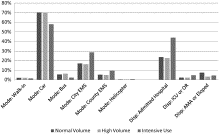Patterns and factors associated with intensive use of ED services: implications for allocating resources
Affiliations
- Yale School of Public Health, Health Policy and Administration, New Haven, CT 06520
Correspondence
- Corresponding author.

Affiliations
- Yale School of Public Health, Health Policy and Administration, New Haven, CT 06520
Correspondence
- Corresponding author.
Affiliations
- Washington University School of Medicine, St Louis, MO
Affiliations
- Washington University School of Medicine, St Louis, MO
 Article Info
Article Info
To view the full text, please login as a subscribed user or purchase a subscription. Click here to view the full text on ScienceDirect.

Fig. 1
Normal volume, high volume, and intensive use of ED by day of the week.

Fig. 2
Differences in mode of arrival and discharge status (disposition) among normal volume, high volume, and intensive use.
Abstract
Aim
This study aims to better understand the patterns and factors associated with the use of emergency department (ED) services on high-volume and intensive (defined by high volume and high-patient severity) days to improve resource allocation and reduce ED overcrowding.
Methods
This study created a new index of “intensive use” based on the volume and severity of illness and a 3-part categorization (normal volume, high volume, intensive use) to measure stress in the ED environment. This retrospective, cross-sectional study collected data from hospital clinical and financial records of all patients seen in 2001 at an urban academic hospital ED.
Results
Multiple logistic regression models identified factors associated with high volume and intensive use. Factors associated with intensive days included being in a motor vehicle crash; having a gun or stab wound; arriving during the months of January, April, May, or August; and arriving during the days of Monday, Tuesday, or Wednesday. Factors associated with high-volume days included falling from 0 to 10 ft; being in a motor vehicle crash; arriving during the months of January, April, May, or August; and arriving during the days of Monday, Tuesday, or Wednesday.
Conclusion
These findings offer inputs for reallocating resources and altering staffing models to more efficiently provide high-quality ED services and prevent overcrowding.
To access this article, please choose from the options below
Purchase access to this article
Claim Access
If you are a current subscriber with Society Membership or an Account Number, claim your access now.
Subscribe to this title
Purchase a subscription to gain access to this and all other articles in this journal.
Institutional Access
Visit ScienceDirect to see if you have access via your institution.
Related Articles
Searching for related articles..


